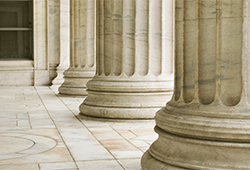 As we noted earlier today, this week the Federal Circuit is holding oral argument at various venues in New York City. Two of today’s oral arguments were in biosimilar cases that we have been closely following on this blog.
As we noted earlier today, this week the Federal Circuit is holding oral argument at various venues in New York City. Two of today’s oral arguments were in biosimilar cases that we have been closely following on this blog.
Janssen v. Celltrion
The morning began with a panel of Judge Reyna, Judge Wallach, and Chief Judge Prost hearing Janssen’s appeal from the district court’s partial final judgment of invalidity of Janssen’s ’471 patent in the Janssen v. Celltrion BPCIA litigation concerning Celltrion’s Inflectra® (infliximab-dyyb) biosimilar product. The district court held that the ‘471 patent is invalid for obviousness-type double patenting (OTDP) over Janssen’s ‘444 patent. One question at issue is whether the later-filed, earlier-expiring, post-URAA ‘444 patent is properly used as a reference patent in holding the earlier filed, later expiring ‘471 patent, which is a pre-URAA patent, invalid for OTDP. The ‘471 patent had also been found invalid for OTDP on grounds that did not implicate URAA related issues. Janssen focused its argument at the hearing on the URAA related OTDP ruling.
The panel also heard argument on a companion case, where Janssen is appealing an ex parte reexamination ruling by the USPTO that the ‘471 patent’s claims are unpatentable for OTDP (on grounds unrelated to the URAA issue described above). The questions at issue included whether the ‘471 patent is properly considered a divisional patent application, such that it can fall within the safe harbor protections available to divisional applications that can protect against a finding of OTDP.
While hearing the first case (the appeal from the district court), the panel questioned each side as to whether the Court would need to reach the issues in the district court appeal if the Court affirms the USPTO’s ruling of unpatentability in the companion case. Both sides responded in the negative.
Amgen v. Apotex
In the afternoon, a panel of Judge O’Malley, Judge Lourie, and Judge Taranto heard Amgen’s appeal in Amgen v. Apotex from the district court’s judgment of non-infringement in favor of Apotex regarding Apotex’s proposed biosimilar of Neulasta (pegfilgrastim). Most of the panel’s questioning focused on infringement, and particularly whether infringement in BPCIA litigation can be proven by relying on the aBLA in a manner similar to the framework established by the Federal Circuit for Hatch-Waxman litigation in Sunovion Pharmaceuticals, Inc. v. Teva Pharmaceuticals, Inc., as argued by Amgen. In its briefing, Amgen asserted that “[u]nder Sunovion, because Apotex’s aBLA specifications ‘directly address[] the infringement question,’ if the specifications ‘would allow’ Apotex to practice an infringing refolding process, ‘a judgment of infringement must necessarily ensue.'” Amgen Reply Br. at 27 (quoting Sunovion, 731 F.3d at 1278).
Amgen also argued that Apotex should not have been allowed to rely on certain arguments that were not timely raised. It was undisputed that Apotex had taken an inconsistent position between trial and its Detailed Statements concerning Amgen’s patents that Apotex provided to Amgen pursuant to 42 U.S.C. § 262(l)(3)(B)(ii)(I) as part of the patent dance prior to the start of litigation. The question facing the panel is whether the district court accorded the correct probative value to Apotex’s inconsistent positions in its Detailed Statement, although at oral argument this was portrayed by the parties as an issue of whether BPCIA Detailed Statements are more akin to Paragraph IV notice letters in a Hatch-Waxman case or to invalidity/non-infringement contentions in district court patent litigation.
The panel also heard arguments about Amgen’s appeal of the district court’s claim construction decision regarding the upper limit of buffer concentration in the claims.

